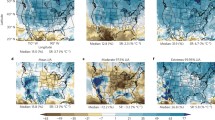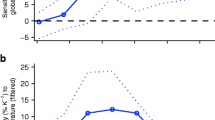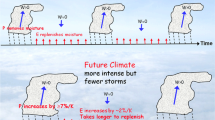Abstract
A physically based conceptual framework is put forward that explains why an increase in heavy precipitation events should be a primary manifestation of the climate change that accompanies increases in greenhouse gases in the atmosphere. Increased concentrations of greenhouse gases in the atmosphere increase downwelling infrared radiation, and this global heating at the surface not only acts to increase temperatures but also increases evaporation which enhances the atmospheric moisture content. Consequently all weather systems, ranging from individual clouds and thunderstorms to extratropical cyclones, which feed on the available moisture through storm-scale moisture convergence, are likely to produce correspondingly enhanced precipitation rates. Increases in heavy rainfall at the expense of more moderate rainfall are the consequence along with increased runoff and risk of flooding. However, because of constraints in the surface energy budget, there are also implications for the frequency and/or efficiency of precipitation. It follows that increased attention should be given to trends in atmospheric moisture content, and datasets on hourly precipitation rates and frequency need to be developed and analyzed as well as total accumulation.
Similar content being viewed by others
References
Boer, G. J.: 1993, ‘Climate change and the regulation of the surface moisture and energy budgets.’ Clim.Dyn. 8 , 225–239.
Brubaker, K. L., Entehabi, D., and Eagleson, P. S.: 1993, ‘Estimation of continental precipitation recycling.’ J. Clim. 6, 1077–1089.
Byers, H. R.: 1948, ‘The use of radar in determining the amount of rain over a small area.’ EOS Trans.AGU 29 , 187–196.
Cubasch, U., Waszkewitz, J., Hegerl, G., and Perlwitz, J.: 1995, ‘Regional climate changes as simulated in time-slice experiments.’ Clim. Change 31 , 273–304.
Fankhauser, J. C.: 1988, ‘Estimates of thunderstorm precipitation efficiency from field measurements in CCOPE.’ Mon.Wea.Rev.116 , 663–684.
Ferrier, B. S., Simpson J., and Tao, W-K.: 1996, ‘Factors responsible for precipitation efficiencies in midlatitude and tropical squall simulations.’ Mon. Wea.Rev. 124 , 2100–2125.
Gaffen, D. J., Barnett, T. P., and Elliott, W. P.: 1991, ‘Space and time scales of global tropospheric moisture.’ J. Clim. 4 , 989–1008.
Held, I. M.: 1993, ‘Large-scale dynamics and global warming.’ Bull.Am.Meteorol.Soc. 74, 228–241.
Hennessy, K. J., Gregory, J. M., and Mitchell, J. F. B.: 1997, ‘Changes in daily precipitation under enhanced greenhouse conditions.’ Clim. Dyn. 13, 667–680.
Hense, A., Krahe P., and Flohn, H.: 1988, ‘Recent fluctuations of tropospheric temperature and water vapour content in the tropics.’ Meteorol.Atmos.Phys., 38, 215–227
IPCC (Intergovernmental Panel of Climate Change): 1996, Climate Change 1995: The Science of Climate Change. Eds. J.T. Houghton, F. G. Meira Filho, B. A. Callander, N. Harris, A. Kattenberg, and K. Maskell, Cambridge Univ. Press, Cambridge, U.K., 572pp.
Iwashima, T., and Yamamoto, R.: 1993, ‘A statistical analysis of the extreme events: Long–term trend of heavy daily precipitation.’ J. Met. Soc. Japan 71, 637–640.
Jones, R. G., Murphy, J. M., Noguer, M., and Keen, A. B.: 1997, ‘Simulation of climate change over Europe using a nested regional-climate model II: Comparison of driving and regional model responses to a doubling of carbon dioxide.’ Quart.J.Roy.Met.Soc. 123 , 265–292.
Kalnay E, Kanamitsu, M., Kistler, R., Collins, W., Deaven, D., Gandin, L., Iredell, M., Saha, S., White, G., Woollen, J., Zhu, Y., Chelliah, M., Ebisuzaki, W., Higgins, W., Janowiak, J., Mo, K-C., Ropelewski, C., Leetmaa, A., Reynolds, R., and Jenne, R. 1996, ‘The NCEP/NCAR Reanalysis Project.’ Bull. Am.Meteorol.Soc. 77 , 437–471
Karl, T. R., and Knight R. W.: 1998, ‘Secular trends of precipitation amount, frequency and intensity in the USA.’ Bull.Am.Meteorol.Soc. 79 , 231–242.
Karl, T. R., Knight, R; W., Easterling, D. R. and Quayle, R. G.: 1996; ‘Indices of climate change for the United States. Bull. Am. Meteorol.Soc. 77, 279–292.
Karl, T. R., Knight, R. W. and Plummer, N.: 1995, Trends in high frequency climate variability in the twentieth century.’ Nature 377 , 217–220.
Mearns, L. O., Giorgi, F., McDaniel, L., and Shields, C.: 1995, ‘Analysis of daily variability of precipitation in a nested regional climate model: comparison with observations and doubled CO2 results.’ Global Planetary Change 10 , 55–78.
Mitchell, J. F. B., Wilson C. A., and Cunnington, W. M.: 1987, ‘On CO2 climate sensitivity and model dependence of results.’ Quart.J.Roy.Met.Sec. 113 , 293–322.
Osborn, T. J., and Hulme, M.: 1997, ‘Development of a relationship between station and grid-box rainday frequencies for climate model evaluation.’ J. Clam. 10, 1885–1908.
Roads, J. O., Marshall, S., Oglesby R., and Chen, S-C.: 1996, ‘Sensitivity of the CCM1 hydrological cycle to CO2.’ J.Geophys.Res. 101 , 7321–7339.
Ross, R. J., and Elliot, W. P. 1996, ‘Tropospheric water vapor climatology and trends over North America: 1973–93.’ J.Clim. 9 , 3561–3574.
Schroeder, S. R., and McGuirk, J. P.: 1998, ‘Widespread tropical atmsopheric drying from 1979 to 1995.’ Geophys.Res.Lett. 25 , 1301–1304.
Suppiah, R., and Hennessy, K. J.: 1998, ‘Trends in the intensity and frequency of heavy rainfall in troipcal Australia and links with the Southern Oscillation.’ Aust.Meteorol.May., 45 , 1–17.
Trenberth, K. E.: 1998, ‘Atmospheric moisture residence times and cycling: Implications for rainfall rates with climate change.’ Clim.Change, 36 , (in press).
Trenberth, K. E., and Guillemot, C. J.: 1996, ‘Physical processes involved in the 1988 drought and 1993 floods in North America.’ J.Clim. 9 , 1288–1298.
Trenberth, K. E., and Hoar, T. J.: 1996, ‘The 1990–1995 El Niño-Southern Oscillation event: Longest on record.’ Geophys.Res.Lett. 23 , 57–60.
Xie, P, and Arkin, P. A.: 1997, ‘Global precipitation: A 17-year monthly analysis based on gauge observations, satellite estimates and numerical model outputs.’ Bull. Am.Meteorol. Soc. 78, 2539–2558.
Zhai, P., and Eskridge, R. E.: 1997, ‘Atmospheric water vapor over China.’ J. Clim. 10 , 2643–2652.
Author information
Authors and Affiliations
Rights and permissions
About this article
Cite this article
Trenberth, K.E. Conceptual Framework for Changes of Extremes of the Hydrological Cycle with Climate Change. Climatic Change 42, 327–339 (1999). https://doi.org/10.1023/A:1005488920935
Issue Date:
DOI: https://doi.org/10.1023/A:1005488920935




